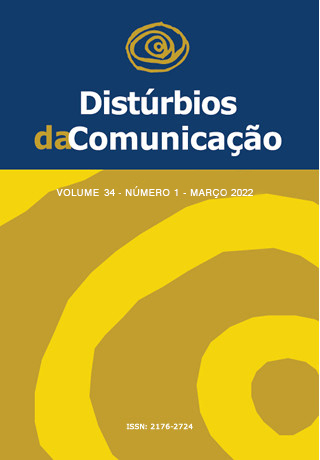Childhood apraxia of speech in cases with comorbidities
DOI:
https://doi.org/10.23925/2176-2724.2022v34i1e53536Keywords:
Comorbidity, Apraxias, Speech Disorders, Child Speech ApraxiaAbstract
Introduction: Childhood apraxia of speech (CAS) can result from neurological impairments associated with complex neurobehavioral disorders or have an unknown nosological entity. Objective: To relate the comorbidities combined with CAS and its clinical manifestations. Data sources: This systematic review was conducted according to the recommendations of the Preferred Reporting Items for Systematic Reviews and Meta-Analyses (PRISMA). The search for scientific articles was carried out in the Medline database (via Pubmed), LILACS, Scopus and SciELO. The search terms used in English were: Comorbidity, Apraxias, Childhood apraxia of speech, Dyspraxia, Speech, and the terms in between. All studies whose subjects had some diagnosed syndrome and / or disorder and apraxia of speech were included. Initially, titles and abstracts of the articles were analyzed. Three independent reviewers evaluated the full articles and made their selections according to the eligibility criteria. At all stages, disagreements were sorted out by consensus. The main data collected was in relation with the occurrence of comorbidities in subjects with CAS. Summary of the findings: The most common comorbidities connected with CAS were Autism Spectrum Disorder, Rolandic Epilepsy and Down Syndrome. Genetic causes come as a predictor of the association between CAS and these comorbidities. Conclusions: Since CAS is a disorder of heterogeneous manifestation, it can come along with several comorbidities, which generates a late diagnosis, for CAS and the secondary disorder, hindering the process of assessment and early intervention, compromising the development of important speech skills.
Downloads
Metrics
References
ASHA: American Speech and Hearing Association. Childhood apraxia of speech: position statement [Internet]. Rockville: American Speech Language-Hearing Association; 2007.
- Shriberg LD, MCswenny JL. Classification and misclassification of childhood of apraxia of speech. Phonology Project Technical Report. 2002, 1-27.
Payão LMC, De Lavra-Pinto B, Wolff CL, Carvalho Q. Características clínicas da apraxia de fala na infância: revisão de literatura. Letras de hoje. 2012; 47 (1): 24-9.
Giannecchini TA, Yucubian-Fernandes A, Maximino LP. Praxia não verbal na fonoaudiologia: revisão da literatura. Rev. CEFAC. 2016; 18 (5): 1200- 8.
Schumacher J, Strand KE, Augustyn M. Apraxia, Autism, Attention-Deficit Hyperactivity Disorder: Do We Have a New Spectrum?. 2009; 36 (2):124-6.
Duchow H, Lindsay A, Roth K, Schell S, Allen D, Boliek CA. The Co-Occurrence of Possible Developmental Coordination Disorder and Suspected Childhood Apraxia of Speech. Canadian Journal of Speech-Language Pathology and Audiology. 2019; 43(2); 81-93.
Shakibayi MI, Zarifian T, Zanjari N. Speech characteristics of childhood apraxia of speech: A survey research. Int J Pediatr Otorhinolaryngol. 2019; 126(11): 1-07.
Geytenbeek J. The use of Dodd’s Model for Differential Diagnosis to classify childhood speech sound disorders. 2018; 61(6): 689-96.
Baumer FM, Cardon AL, Porter BE. Language Dysfunction in Pediatric. 2017; 194; 1-19.
Souza TNU, Payão LMC, Costa RCC. Apraxia da fala na infância em foco: perspectivas teóricas e tendências atuais. Pró-Fono Revista de Atualização Científica. 2017; 21(1): 75-80.
Pal DK. Li W, Clarke T, Lieberman P, Strug LG. Pleiotropic effects of the 11p13 locus on developmental verbal dyspraxia and EEG centrotemporal sharp waves. 2010; 9(8):1004-12.
Scheffer I. E. Autosomal dominant rolandic epilepsy with speech dyspraxia. Epileptic Disorders. 2000; 2(4):19-22.
Newmeyer AJ, Aylward C, Akers R, Ishikawa K, Grether S, Grauw T, Grasha C, Branca J. Results of the Sensory Profile in Children with Suspected Childhood Apraxia of Speech. 2009; 29(2): 203-18.
Nijland L, Terband H, Maassen B. Cognitive Functions in Childhood Apraxia of Speech. 2015; 58(3): 550-65.
Teverovsky EG; Bickel JO, Feldman H. Functional characteristics of children diagnosed with Childhood Apraxia of Speech. 2009; 31 (2): 94-102.
Printz T, Mehlum CS, Nikoghosyan-Bossen G. Verbal and oral dyspraxia in children and juveniles. 2018; 180(12): 1-6.
Kumin L. Speech intelligibility and childhood verbal apraxia in children with Down syndrome. 2006; 10(1): 10-22.
Maia C, Moreira A, Martins C. Epilepsia em idade pediátrica: casuística da consulta de pediatria de um hospital distrital. Nascer e Crescer. Birth And Growth Medical Journal. 2017; 26(2): 109-13.
Oliveira EPM, Neri ML, De Medeiros LL, Guimarães CA, Guerreiro MM. Avaliação do desempenho escolar e praxias em crianças com Epilepsia Rolândica. Pró-Fono Revista de Atualização Científica. 2010; 26(2): 10-22.
Ballaban-Gil, Tuchman R. Epilepsy and epileptiform EEG: association with autism and language disorders. 2000; 6(4): 300-8.
Pinto RNM, Torquato IMB, Collet N, Reichert APDS, Souza Neto VLD, Saraiva AM. Autismo infantil: impacto do diagnóstico e repercussões nas relações familiares. Revista Gaúcha de Enfermagem. 2016; 37(3): 1-9.
Maski KP, Jeste SS, Spence SJ. Common Neurological comorbidities in Autism Spectrum Disorders. Current Opinion in Pediatrics. 2011; 23(6) 609-15.
Tierney C, Mayes S, Lohs SR, Black A, Gisin E, Veglia M. How Valid Is the Checklist for Autism Spectrum Disorder When a Child Has Apraxia of Speech? 2015; 36(8): 569-74.
Northam G, Morgan TA, Fitzsimmons S, Baldeweg T, Liègeois FJ. Corticobulbar Tract Injury, Oromotor Impairment and Language Plasticity in Adolescents Born. 2019; 19(1) :13:45.
Iuzzini-Seigel J, Hogan TP, Green JR. Speech Inconsistency in Children With Childhood Apraxia of Speech, Language Impairment, and Speech Delay: Depends on the Stimuli. 2017; 60(5): 1194-210.
Crestani AH, et al. Distúrbio específico de linguagem: a relevância do diagnóstico inicial. Revista CEFAC. 2012; 15(1): 228-37.
Kumin L, Adams J. Apraxia of speech development and intelligibility in children with Down syndrome. Downs Syndr Res Pract. 2006;10(1): 10-22.
Gammom SC. Phonological development in Down syndrome. Mental Retardation and Developmental Disabilities Research Reviews. 1998; 3(4): 300-06.
Coelho JF et al. Perfil de fala na síndrome de Down: apraxia de fala X distúrbio de fala de origem musculoesquelética. Revista CEFAC.2020; 22(5): 1-11.
Downloads
Published
How to Cite
Issue
Section
License
Copyright (c) 2022 Aline Mara de Oliveira, Amanda Del Nero Alves Pires, Greicyhelen Santos da Cruz, Léia Gonçalves Gurgel, Luciane Mari Deschamps

This work is licensed under a Creative Commons Attribution 4.0 International License.







